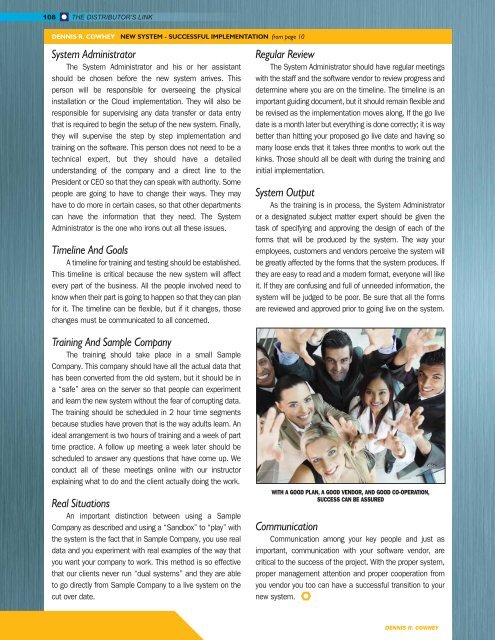WINTER 2016
Distributor's Link Magazine Winter Issue 2016 / Vol 39 No1
Distributor's Link Magazine Winter Issue 2016 / Vol 39 No1
Create successful ePaper yourself
Turn your PDF publications into a flip-book with our unique Google optimized e-Paper software.
108 THE DISTRIBUTOR’S LINK<br />
DENNIS R. COWHEY NEW SYSTEM - SUCCESSFUL IMPLEMENTATION from page 10<br />
System Administrator<br />
The System Administrator and his or her assistant<br />
should be chosen before the new system arrives. This<br />
person will be responsible for overseeing the physical<br />
installation or the Cloud implementation. They will also be<br />
responsible for supervising any data transfer or data entry<br />
that is required to begin the setup of the new system. Finally,<br />
they will supervise the step by step implementation and<br />
training on the software. This person does not need to be a<br />
technical expert, but they should have a detailed<br />
understanding of the company and a direct line to the<br />
President or CEO so that they can speak with authority. Some<br />
people are going to have to change their ways. They may<br />
have to do more in certain cases, so that other departments<br />
can have the information that they need. The System<br />
Administrator is the one who irons out all these issues.<br />
Timeline And Goals<br />
A timeline for training and testing should be established.<br />
This timeline is critical because the new system will affect<br />
every part of the business. All the people involved need to<br />
know when their part is going to happen so that they can plan<br />
for it. The timeline can be flexible, but if it changes, those<br />
changes must be communicated to all concerned.<br />
Regular Review<br />
The System Administrator should have regular meetings<br />
with the staff and the software vendor to review progress and<br />
determine where you are on the timeline. The timeline is an<br />
important guiding document, but it should remain flexible and<br />
be revised as the implementation moves along. If the go live<br />
date is a month later but everything is done correctly; it is way<br />
better than hitting your proposed go live date and having so<br />
many loose ends that it takes three months to work out the<br />
kinks. Those should all be dealt with during the training and<br />
initial implementation.<br />
System Output<br />
As the training is in process, the System Administrator<br />
or a designated subject matter expert should be given the<br />
task of specifying and approving the design of each of the<br />
forms that will be produced by the system. The way your<br />
employees, customers and vendors perceive the system will<br />
be greatly affected by the forms that the system produces. If<br />
they are easy to read and a modern format, everyone will like<br />
it. If they are confusing and full of unneeded information, the<br />
system will be judged to be poor. Be sure that all the forms<br />
are reviewed and approved prior to going live on the system.<br />
Training And Sample Company<br />
The training should take place in a small Sample<br />
Company. This company should have all the actual data that<br />
has been converted from the old system, but it should be in<br />
a “safe” area on the server so that people can experiment<br />
and learn the new system without the fear of corrupting data.<br />
The training should be scheduled in 2 hour time segments<br />
because studies have proven that is the way adults learn. An<br />
ideal arrangement is two hours of training and a week of part<br />
time practice. A follow up meeting a week later should be<br />
scheduled to answer any questions that have come up. We<br />
conduct all of these meetings online with our instructor<br />
explaining what to do and the client actually doing the work.<br />
Real Situations<br />
An important distinction between using a Sample<br />
Company as described and using a “Sandbox” to “play” with<br />
the system is the fact that in Sample Company, you use real<br />
data and you experiment with real examples of the way that<br />
you want your company to work. This method is so effective<br />
that our clients never run “dual systems” and they are able<br />
to go directly from Sample Company to a live system on the<br />
cut over date.<br />
WITH A GOOD PLAN, A GOOD VENDOR, AND GOOD CO-OPERATION,<br />
SUCCESS CAN BE ASSURED<br />
Communication<br />
Communication among your key people and just as<br />
important, communication with your software vendor, are<br />
critical to the success of the project. With the proper system,<br />
proper management attention and proper cooperation from<br />
you vendor you too can have a successful transition to your<br />
new system.<br />
DENNIS R. COWHEY

















